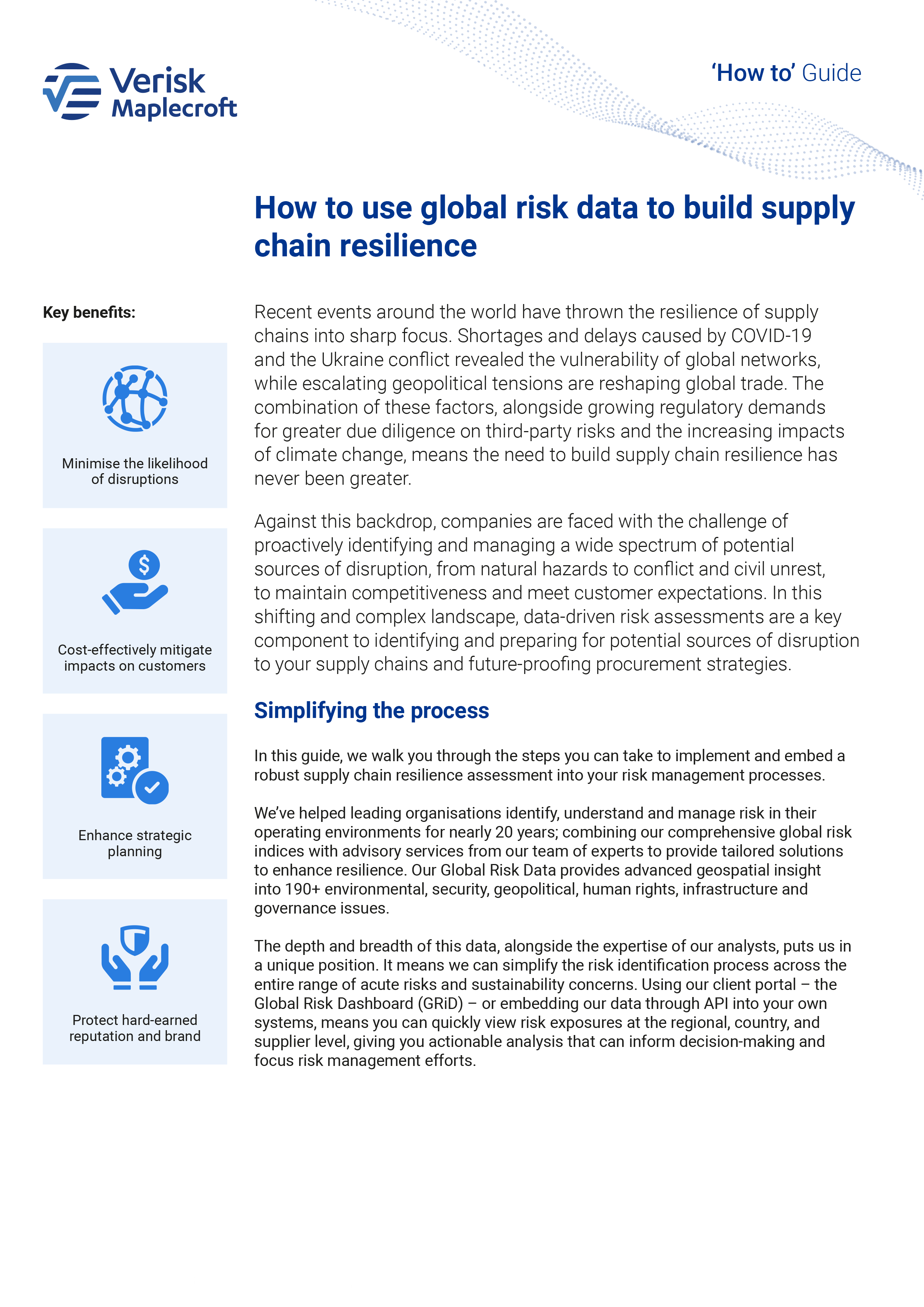Rising global temperatures pose an increasing risk to the resilience of well over half of the world’s top 100 data centre hubs, according to our latest research. Growing cooling requirements will increase water and electricity demand, exposing data centres to rising costs, potential conflict with local communities over resources and power outages where energy infrastructure is less resilient to climate change.
Data centres are built with resilience measures, such as backup generators, at the forefront of their design and water and energy efficiencies are improving. Yet our analysis suggests that the pressures of climate change could test this increasingly essential infrastructure as temperatures spike and demand for AI, data storage and cloud computing surges.
“Data centres now form the digital backbone of business. The third-party operators of these facilities represent a critical link in global supply chains, as their services underpin the operations of all multinational organisations,” says Laura Schwartz, Senior Asia Analyst. “In an always-on, globally integrated economy, understanding the entire range of risks that can impact their resilience is a board-level imperative that needs mapping out today and into the future.”
Cooling requirements of data centres to spike amid rising temperatures
Heat waves already constitute a major risk to data centres. During extreme temperature spikes, operators can be forced to shut down servers to prevent damage from overheating, leading to service disruptions. In 2022, summer heat waves in the UK and US caused several data centres to go offline, disrupting businesses reliant on cloud-based servers.
Our Cooling Degree Days Index measures how often and by how much temperatures are likely to exceed a threshold triggering cooling requirements for buildings. Currently 56% of the top 100 data centre hubs score as ‘high’ or ‘very high’ risk for cooling degree days, but in a high-emissions scenario (SSP5-8.5), this increases to 68% by 2040 – and 80% by 2080.
This means around three-quarters of the world’s data centre hubs will have to meet significant and increasing cooling demands for longer periods each year, resulting in higher water and energy usage and costs. The top 100 data centre hubs will on average see an 83% increase in cooling degree days from 2030 to 2080.
Under the SSP5-8.5 scenario, all data hubs in Asia-Pacific and the Middle East fall within the ‘high’ or ‘very high’ risk category of our Cooling Degree Days Index by 2040. In North America, the percentage of data hubs in the two highest risk categories is set to increase from 55% now to 71% in 2040 and 90% in 2080.
Over half of top data centre hubs in highly water stressed areas
For many data centres, the key ingredient for cooling is water, but indirect usage from electricity generation is also significant. The average mid-size data centre uses about 300,000 gallons (1.4 million litres) of water a day and these requirements will only increase as temperatures rise.
By 2030, under SSP5-8.5, 52% of global data centre hubs are categorised as facing ‘high’ or ‘very high’ risk in our Water Stress Index, which evaluates total water use relative to total annual available flow. By 2050, this rises to 58%. Given growing water use requirements due to increasing demand for data centres and rising temperatures, water scarcity is likely to become a double-edged resilience and sustainability risk in companies’ supply chains for IT and cloud-based services.
The risks are, however, not contained to availability – they have the potential to spill over into the social and political realms. Conflict over access to water with local communities can spark unrest, becoming a political issue that can threaten social license to operate and the reputations of organisations using affected sites for digital services.
Unsurprisingly, the Middle East faces the highest exposure to water stress risks with Abu Dhabi, Dubai and Istanbul all rated as ‘very high’ risk by 2030. In Africa, Lagos, Johannesburg and Nairobi are all projected to be in the same category by 2050, while half of North America’s top data centre hubs will score ‘high’ or ‘very high’ risk for water stress in just five years. Los Angeles, San Diego, Denver, Phoenix and Mexico City face some of the highest risks.
Data centre capacity in Asia is set to nearly double by the start of the next decade, exacerbating water availability concerns. Between 2030 and 2050, water stress risk is projected to increase most significantly in Manila and Bangkok and will remain ‘very high’ in several Indian hubs, including Chennai and New Delhi.
Intensifying climate hazards a key risk to energy reliability
Data centres’ energy use is already straining power grids across the world. They currently account for around 1.5% of global electricity demand, but by 2030 this is expected to reach 3%. Cooling currently accounts for up to 40% of this demand, but this will increase as temperatures rise.
Our Energy Infrastructure Index assesses 165 countries on their energy generation capacity, diversity, distribution reliability and innovation. The importance of energy reliability in investment decisions is reflected in this index, which categorises 70% of top data centre hubs as ‘low’ risk.
Significantly, extreme heat reduces the efficiency of power transmission, presenting a further complication for energy infrastructure in the face of growing demand. Data centres are sensitive to variations in supply, so consistent power is key to reducing outage risks. They do have short-term backups to deal with minor interruptions, but switching over to these systems is not 100% reliable and can cause grid issues due to large changes in demand.
The changing climate will increasingly impact ageing power infrastructure even in currently ‘low’ risk markets. According to our Climate Hazard Index, which measures eight different acute and chronic climate hazards, 27% of the top 100 data hubs, mostly located in Asia and the Middle East, are going to be at ‘high’ or ‘very high’ risk by 2050 under a high emissions scenario. All but one face at least ‘medium’ risk. This means many data centre hubs face more hazardous and extreme conditions from storms and rising temperatures, which could challenge the reliability of energy supply and the resilience of operations.
Combatting resilience and sustainability challenges
Data centres are long-term investments that will be subject to shifts in the risk landscape across a range of issues in their lifespan. Anticipating where these risks will emerge is a strategic concern for all global organisations that operate or use these services.
“Data centre operators are innovating solutions to increase resilience and offset sustainability concerns, but rising temperatures increase these challenges,” adds Capucine May, Consultant. “The onus is on operators, customers and investors alike to assess rising climate threats, alongside social and political risk factors – not only for their own resilience, but because of a growing regulatory focus on third-party risk management.”





